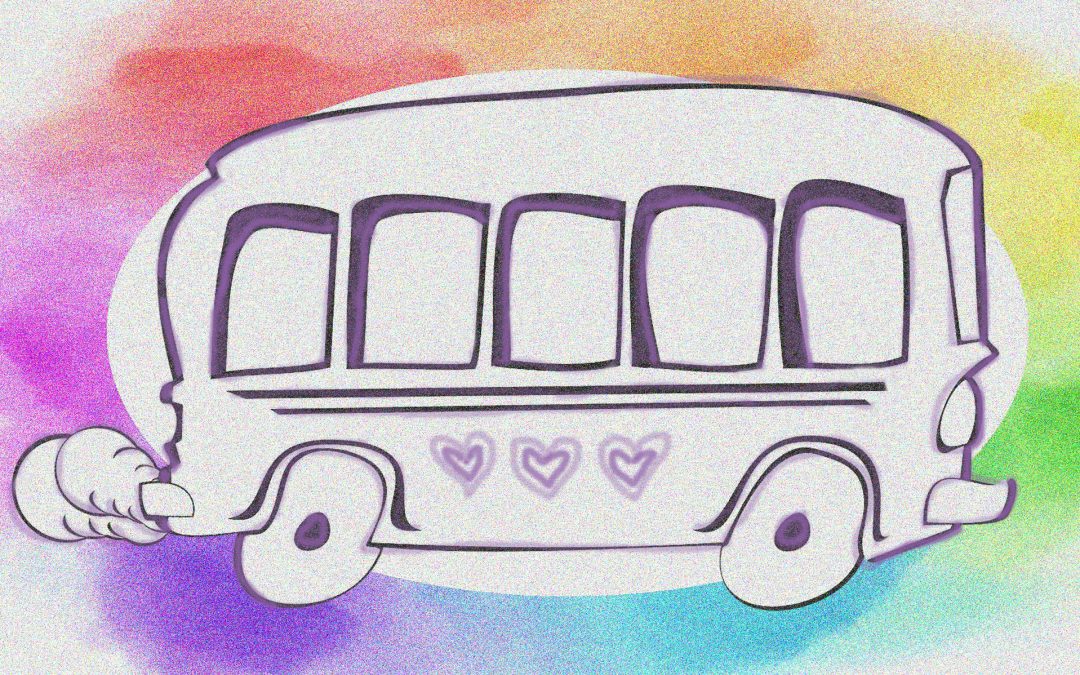Be not quick to judge…
Oh, but I was, and I was judging hard.
It was a gloomy, dim day in my first-grade classroom. Maybe it was actually sunny outside, but since the classroom was in the building of the local Masonic Temple (long story), it was always dim inside. But I digress…
So, on that day in that first-grade room, the teacher (Mrs. Sadler; I even remember her name!) gave each of us students a sheet of paper, so fresh from the printing machine we could still smell the purple ink solvent (yuck). On the paper was a line drawing of a school bus, and the title “Color the School Bus.”
“Color the School Bus.” Hooray! A coloring assignment! I loved to draw and to color, even when the picture was already drawn, as in a coloring book. And even better, I had a brand-new pack of Crayola crayons. And even better than that, my pack of crayons contained 24—twenty-four!!—different colors. In my mind, I was planning how to color my picture even before Mrs. Sadler’s instructions were given.
I pulled out the crayons I’d need and I set to work coloring that school bus picture. I distinctly recall how excited and pleased I felt as I figured out how to mix layers of the yellow, orange, yellow-orange, and even a light layer of black waxes to get the classic “school bus yellow” hue. I added the black accents on the bus, and even thought to creatively add lettering on the side of the bus denoting my town’s school district. The entire exercise just felt so exciting and satisfying to my 6-year-old artist’s sensibilities.
But then, taking a second to reflect on what to do next, I looked around at what my classmates at the desks near me were doing with their pictures. I was shocked! Not a single one was coloring their buses correctly. They were all using colors that weren’t even ON a school bus, and they had all chosen very strange color combinations, to boot: part of a bus might be brown, and another part red, another part green, yet another part purple, etc.
I thought how ugly those buses looked with all those ridiculous colors, and felt scorn for my classmates, who obviously didn’t know or care what a real school bus looked like. Or maybe they were just stupid (“dumb” was the term we used to insult, back then: “That’s a dumb idea!” or “You’re so dumb!”). At any rate, I was mentally criticizing and insulting my classmates. With an internal shaking of my head, I went back to work to put the finishing touches on my wonderful picture before the teacher collected our papers.
The next day, Mrs. Sadler gave our graded papers back to us. Expecting to see the usual “S+” at the top of mine, I was startled and horrified to see a big “U” at the top of the page, with a note from the teacher that said something to the effect of “nice picture, but you did not follow the directions.”
Directions?! What directions? Then for the first time, I noticed that, printed at the bottom of the page was a section with the heading “Directions.” And those directions indicated that there were numbers printed on parts of the picture, with each number representing a color that was to be used in that part. It was a “color by number” picture, and the colors represented were—you guessed it—brown, red, green, purple, etc.
I was no longer just startled and horrified by the grade of “Unsatisfactory” on my paper. An even worse feeling took over: I felt absolutely mortified. The classmates for whom I had felt such scorn and pity the day before had actually been doing the assignment correctly! The buses were still ugly, in my opinion, but they were “right,” because they were what had been called for. I felt so bad—embarrassed, guilty, ashamed—for having judged my classmates so harshly, especially when it was I who was in the wrong about the assignment.
Mrs. Sadler— Doris, I’ve just remembered—was a kind and patient teacher with a merciful attitude, and she gave me the chance for a do-over. I recall being given that chance, but honestly can’t recall if I accepted the opportunity. Probably I did, but that’s not what I remember.
What I remember is that I didn’t deserve a do-over because I was so wrong to have judged my classmates as I had. That’s a pretty heavy self-judgement for a 6-year-old, and apparently it sank deep, as I carried that inside me unconsciously well into my adulthood. When the specific event memory came to my conscious level once again, I was able to process it. As an adult, I was able to see it in a larger perspective, to have compassion for both myself my long-ago classmates, and to find the valuable lessons in the experience while letting the outgrown and now-useless aspects go.
Uncovering, processing, and releasing the parts of our experiences that have long ago stopped serving our Highest Good can sometimes feel impossible, overwhelming, difficult, and painful, but are necessary for anyone on a path of spiritual growth. Necessary, and ultimately very satisfying—even better than finding just the right crayon colors to match a real-life school bus!

